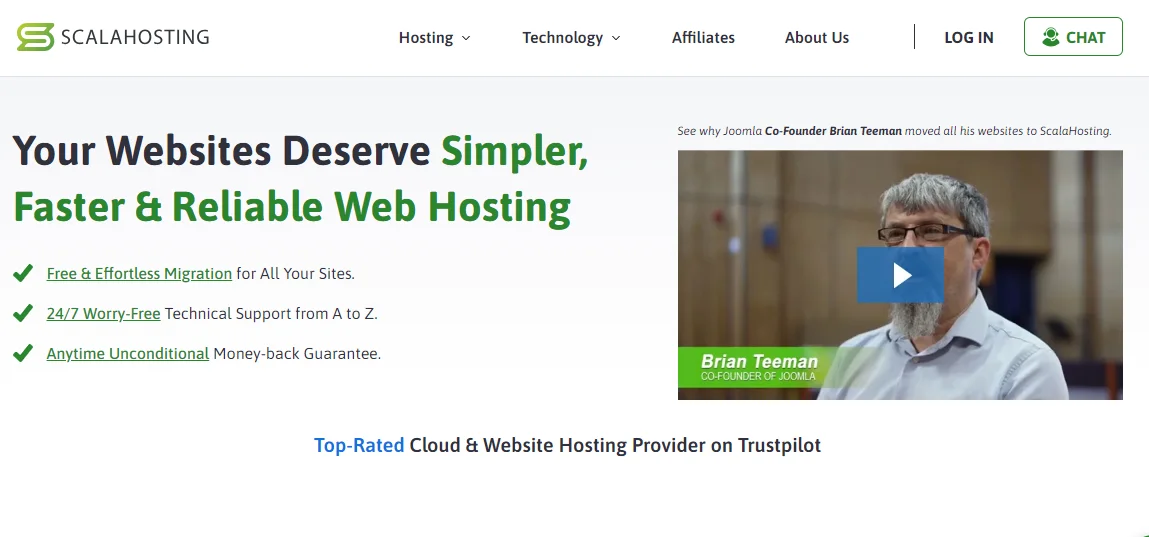
Hosting management: is Bluehost easy to use?
When it comes to ease of use, Bluehost is up there with the best hosting providers. It combines in-house website management tools with cPanel. This results in excellent functionality, features, and tools that are easy to find, and a simply comfortable hosting experience.
Bluehost setup process
The Bluehost setup process is simple and uncomplicated, and you as the client are given guidance every step of the way:
- Once you create your account or log in, head to the Domains section on the left-hand side menu.

- Here, you will see the status of your domains, as well as the options to buy or transfer domains.
- Under Domain Connections, you can choose to connect a website, an email, or a hosting service to your domain. Choose whichever, and add a name and domain.

- Bluehost will create a site, and take you to the control panel. Here you can see the basic site information, edit the site, adjust settings, and more. Server information is also there.

- If you choose to create a custom site (instead of using WordPress, for example), the main menu will be emptier and contain the Content Management System (CMS) and the phpMyAdmin panel. The phpMyAdmin panel is where you can develop and edit your site. However, this option is not recommended for beginners, as you need to know PHP, understand environments, hosting options, and more.
Bluehost control panel
For site management, Bluehost uses an in-house system called My Sites in combination with the well-known (and well-loved) cPanel. My Sites is one of the most convenient hosting management systems we’ve tested. It’s where you can find the performance optimization section, security, the plugin dashboard, and settings. Here’s what you can do with Bluehost’s My Sites:
- Configure site caching and Content Delivery Network (CDN)
- Enable or disable free SSL, add extra services, and check if WordPress core files are intact
- Activate, deactivate, and update WordPress plugins from your dashboard.
- Update the site URL if you’ve changed it, set the limit of post/page revisions that are saved in your WordPress, disable the comments after a certain time, and choose how many of them to display per page, set up a Coming Soon Page, or even delete your site easily.
In the Advanced menu option on the My Sites page, you will find cPanel. Here you can find the more technical side of hosting management – changing PHP versions, accessing databases, or configuring free email accounts. Things like domain management, however, are part of the native Bluehost management system.

Bluehost for WordPress
Bluehost is one of the best WordPress hosting providers. It offers one-click WordPress installation, and one free WordPress site migration for any user. During our research, we found Bluehost WordPress hosting (installation and migration included) intuitive and easy to use. The site migration is especially easy to conclude, as the native Bluehost Site Migrator does most of the work.
Here’s more information on how to install or migrate a WordPress site on Bluehost:
Install WordPress:
- After creating your account or logging in, choose the “Install WordPress” option in “Add Website” panel.
- Create your site name, connect a domain, or use a temporary domain. You can also skip this step.
- Wait for the WordPress site to be installed. It took us less than a minute.
- After the installation finishes, you will be taken to the summary page. Click on “Edit Site” to edit your WordPress site. Here you can choose to migrate a site, or to just start fresh.
If you want to start a fresh WordPress site, you will be prompted to use the Bluehost website builder. The builder offers plenty of design and template options, and offers guidance in the form of questions about your site’s purpose (wether it’s a shop, a blog, a portfolio, and more).
If you want to migrate an existing site, follow these steps:
- Enter the URL of your existing WordPress site that you want to migrate.
- Install the Bluehost Site Migrator.
- Copy and paste the transfer key to complete the transfer.
- After that, the Site Migrator will do most of the work to migrate your WordPress website.
If you need help with migrating your site, you can buy a Bluehost migration service for $149.99. A Bluehost expert will take care of the whole site migration process.
However, the Bluehost Site Migration is not a well-received tool. It only has 1,5 stars out of 24 reviews with >8K active installations. Our research shows that there are better migration tools, such as Updraft Migration Plugin, which has a 5star rating with >7K reviews and >3M active installations.
Essential features: SSL, marketing tools, staging, email, and site migration
Bluehost includes numerous features to make your hosting experience professional, smooth, and convenient. Security features, marketing tools, staging environments, email, and site migration are all available.
SSL is one of the most important security features that a hosting provider can offer. Bluehost offers a free SSL certificate that installs automatically when a domain is attached. An SSL certificate is essential in establishing a secure connection with your site’s visitors.
The Marketing Tools section is a functional yet simple user interface where you can set up the foundation for your online business visibility – order SEO Tools, integrate Google Ads, and list yourself on Google My Business.

So let’s take a quick look at how these tools can help your business succeed:
- SEO Toolkit: this is a paid option starting at $5.95/mo that gives you a detailed SEO plan and tracks your progress. While it’s not as detailed as Ahrefs, it’s much more affordable.
- Google Ads: ads will make you visible to a particular audience that you want to target, making them one of the most efficient marketing strategies. So Bluehost makes it simpler by integrating an intuitive platform to set up and track the ads as well as do A/B testing. Plus, Google Ads match up to $150 on your first campaign.
- Google My Business: Google My Business is an easy way to get your business listed on Google Maps, and such queries like “pizza near me.” Usually, you’d do that from a Google account, but Bluehost integration makes it possible to set up from your hosting account.
Bluehost also includes professional email accounts. In the cPanel, go to Email Accounts and find the Create button. Fill in all the necessary details such as username as well as password and set the allocated storage space for the email account. For the email client, you have 2 options: Roundcube and Horde. While these email clients are somewhat outdated, they get the job done.
Bluehost email hosting works on the same server as your website. This means that these email accounts should not be used for big marketing campaigns or frequent advertising.
When it comes to website migration, Bluehost offers both a free and a paid option. However, while paid migration is accessible to everyone, free migration has its own requirements:
- Free migration requires a new (first-time) shared hosting account,
- The migration has to take place sometime within the first 30 days of purchasing a shared hosting plan,
- The site itself has to be a WordPress version no older than 4.7 and run on at least PHP version 7.0 or later,
- The website (filesize) must be no larger than 2GB in size,
- The database size must not exceed 40MB,
- The website must be free of malware.
Here’s a breakdown of the differences between free and paid Bluehost migration:
| Price | For whom? | How many migrations are available? | What’s not transferable? | |
| Free migration | Free | First-time users | 1 WordPress site | Email and domain name |
| Paid migration | $149.99 | New or existing users | 5 websites on any CMS and up to 20 email accounts | Domain name |
Bluehost does not offer migration support for VPS, Reseller, or Dedicated Server hosting accounts.
Bluehost also includes a staging tool for your WordPress website. It allows you to fix issues or test updates on a demo website without affecting your live site. That’s an excellent addition that can save a lot of headaches when building or updating your site.

To create a staging copy, simply hit the Create Staging Site button. This will duplicate your website. Before making any changes to the staging site, you might want to click the Clone to Staging button. This way you’ll know for sure that you’re working with the latest copy of your site.
Performance – Bluehost speed, uptime, and stress testing
To test the performance of Bluehost, we conducted a series of tests, including uptime and response time, as well as how fast a site loads, and how many visitors it can handle at once. All tests were done on a shared hosting plan, and with a fully built site to simulate how a host would perform in real-life scenarios as best as possible. Therefore, some results, such as load speed and server response time may be higher than with an empty site.
Overall, Bluehost’s performance is well above average. It loads websites quickly and there are no issues with downtime. It also handles spikes in traffic quite well, and provides and overall reliable performance, perfectly suitable for small-to-medium sites.
Bluehost uptime and response time
In hosting, uptime refers to the availability of your site to users, i.e. how long the site is up and running per set amount of time. In terms of long-term monitoring, Bluehost scored 99.63% uptime over 30 days of testing. Bluehost does not offer an uptime guarantee like other providers, and yet the uptime is near perfect, with the ideal goal being 100%, which is something that few providers ever reach. With that in mind, Bluehost uptime results are considered very good.

Server response time, also known as TTFB, is how long it takes for the host server to process a website visitors’ request to reach the website. Server response time also includes latency (visible in the image), which is essentially the minimum time a server requires to produce any kind of response (not including processing time). Therefore, overall server response time (TTFB) will always be higher than latency.
In our Bluehost tests, the average server response time was 971ms, which is not a terrible but also not a great result. Considering that testing was done with a fully built site, this is a satisfactory overall result.
Bluehost speed test
The next test shows how fast a fully-built WordPress website can load when tested in different locations. Largest Contentful Paint is the main indicator of this site-loading speed. Our Bluehost website is hosted in the US, so that’s where we got the fastest result – the Largest Contentful Paint (LCP) is 1.3s. LCP results in the UK and India were 1.2s and 2.2s, respectively.

Largest Contentful Pain is the most important result as Google takes it into consideration when ranking your site. Also, it’s an indicator for the visitor that the website is loading properly. The benchmark for LCP is up to 2.5 seconds, and Bluehost passes with flying colors in all tested locations, as is fitting for one of the best and fastest hosting providers.
Bluehoost stress testing
In the last test, we wanted to see how well Bluehost can handle increased traffic on the site – this is called stress testing. We sent 50 virtual users (VU) to our Bluehost site and monitored the server response time and request handling.
Bluehost handled 50 virtual users without any failure.In the best case scenario, the blue line, which indicates server response time should remain flat as the number of visitors (grey line) increases. During our testing, we saw a few spikes in the response time, but overall it remained pretty consistent, which is a good sign. The server also handled all the requests just fine.

Bluehost security
Bluehost has plenty of security features. However, to access and activate these security measures, you’ll either have to purchase them via Bluehost or a third-party provider.
Let’s have a peek at what is Bluehost doing when it comes to the more vital security measures. This includes SSL certificates, DDoS protection, and firewalls.
- SSL certificates – all Bluehost’s shared plans come with a free Let’s Encrypt SSL certificate, additionally, there are a few paid options. However, the free version should be sufficient for most Bluehost users.
- DDoS protection – Bluehost provides protection against DDoS via Cloudflare. A DDoS attack is a malicious attack where your site is flooded with traffic from a compromised system to overwhelm and disrupt it. By activating Cloudflare, you can hide your origin IP address from a direct attack by proxying traffic to Cloudflare.
- Firewalls – while there seems to be no default firewall for shared hosting, Bluehost does use iptables as a firewall for its dedicated and VPS plans. So if you’re using shared hosting, my suggestion is to turn to free plugins. For instance, Jetpack and Wordfence will get the job done at zero cost.
- Automatic backups – this is a useful tool that can save you in case of an emergency. Basically, it takes a snapshot of your website daily and you can restore it at any time. They are included in Choice Plus and Pro plans but otherwise cost $2.99/mo via a third-party tool.
Overall, Bluehost definitely doesn’t have the best or most comprehensive features when it comes to security. It’s a shame that it charges for security measures that are pretty much essential.
What are the types of Bluehost hosting?
Like many other hosting services, Bluehost offers several types of hosting plans – shared, VPS, and dedicated hosting. Find short overviews of what each type of hosting includes, and whom it is for below:
Bluehost shared hosting
Bluehost offers 4 shared hosting plans that come at an affordable price. All include unmetered bandwidth, a free SSL certificate, CDN, and a custom domain registration.
Bluehost VPS hosting
VPS (virtual private server) is the next step when a business outgrows shared hosting. Provider’s VPS hosting plans start at $19.99/mo and go up to $59.99/mo.
Based on the price, all Bluehost VPS plans include different amounts of CPU cores, storage, RAM, bandwidth, and IP addresses.
VPS plans are managed, meaning that the provider launches the server for you and takes care of the software/maintenance, not just the hardware. You also get a customer dashboard and cPanel for server and website management. Plus, full root access is provided too. Many other providers offering managed services do not give you full control over the server.
Bluehost dedicated hosting
Dedicated server hosting steps in when even the most powerful VPS plans are not enough. While pricey, this is the go-to option for large businesses and enterprises that need full server control, power, and security. Bluehost dedicated plans start at $89.98/month and go up to $139.99/month.
All dedicated hosting plans include from 3 to 5 dedicated IPs, 1 free domain, and 4 core CPUs. The amount of storage, RAM, cache, and bandwidth all differ based on the plan.
Bluehost hosting plans and pricing
Bluehost prices range from cheap to enterprise-grade with shared hosting packages starting at an introductory price of $2.95/month.
For different needs, there are also VPS, managed WordPress, and dedicated servers.
| Basic | Plus | Choice Plus | Pro | |
| Price | $2.95/month | $5.45/month | $5.45/month | $8.99/month |
| Websites | 1 | Unlimited | Unlimited | Unlimited |
| SSD storage | 10GB | 20GB | 40GB | 100GB |
| Free SSL | ✅ | ✅ | ✅ | ✅ |
| Free CDN | ✅ | ✅ | ✅ | ✅ |
| Free Email | ✅ | ✅ | ✅ | ✅ |
| Custom Domain | ✅ | ✅ | ✅ | ✅ |
| Domain privacy | ❌ | ❌ | ✅ | ✅ |
| Daily Backup | ❌ | ❌ | ✅ | ✅ |
| Dedicated IP | ❌ | ❌ | ❌ | ✅ |
In-advance payments are pretty much regular in order to get that cheap advertised price. So in terms of introductory prices, Bluehost is on the same level as other cheap hosting providers.
By the way, a 30-day money-back guarantee is available but there are certain conditions:
- The payment has to be made via credit card.
- Extra services are non-refundable.
- If you’ve got a free domain, the regular domain fee will be deducted from the refund, and you’ll keep the ownership of that domain.
All in all, Bluehost pricing is standard but plans are generously packed with resources. It’s a good option to start a website as you won’t have any additional costs in the first year. Take a look at our list of Bluehost Black Friday deals for great discounts.






